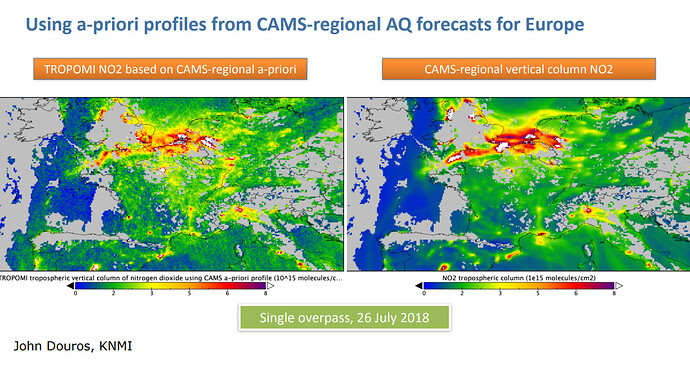Hi Sander,
I hope you are well!
I have a question regarding the use of averaging kernels with NO2 products in HARP.
The S5P ground processing chain for NO2 L2 products uses an Apriori NO2 profile from TM5 model. This model has a ground resolution of 1°x1° which can lead to underestimation of NO2 column in areas where NO2 concentration is higher. The product user manual (page 22) and experts advise to use more precise apriori profiles like the CAMS-regional European forecast for example. This model has a ground resolution of 0.1°x0.1° on 8 altitude levels. Here is what I want to achieve:
And I want to end up with something like this:
Both images are from the presentation of Henk Eskes on NO2 satellite applications during the second joint school on Atmospheric composition at which you were also a trainer if I am not wrong.
Before using CAMS model data and S5P products altogether, I wanted to reproject S5P NO2 products on a 0.1°x0.1° grid using bin_spatial() and also regrid the S5P vertical levels from the 34 TM5 pressure layers to 8 altitude levels with derive(altitude {latitude,longitude,vertical}) and a regrid() operation. However bin_spatial() removes the tropospheric_NO2_column_number_density_avk from the imported product. I tried to use a derive(tropospheric_NO2_column_number_density_avk {latitude,longitude,vertical}) to keep it within the imported product and it does not work. The derive() operation on altitude does not work either. Moreover, the harpdump–list-derivations applied to the S5P L2 NO2 product does not offer the possibility of deriving the tropospheric averaging kernel or the altitude.
I also feel that I could use an operation like derive_smoothed_column() operation to achieve what I want. But it apparently needs to be used on collocated products which seems to indicate a previous use of harpcollocate on S5P L2 NO2 and CAMS model product. However, the use of harpcollocate is not completely clear to me and I could not find examples in the documentation.
Is there a way to perform what I want with HARP? E.g using the CAMS AQ forecast NO2 model profile as an apriori profile to recompute the TROPOMI NO2 tropospheric NO2 column? I am pretty sure there is but I have not been able to find my way through it yet. I am kindly asking for your support here.
Thank you in advance for your help.
Simon


